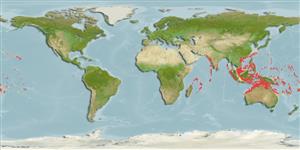Common names from other countries
Teleostei (teleosts) >
Eupercaria/misc (Various families in series Eupercaria) >
Malacanthidae (Tilefishes)
Etymology: Hoplolatilus: Greek, hoplon = weapon + Latin, latus = wide (Ref. 45335).
More on authors: Randall & Dooley.
Environment: milieu / climate zone / depth range / distribution range
Ecology
Marine; reef-associated; depth range 25 - 115 m (Ref. 1602), usually 30 - 115 m (Ref. 27115). Tropical; 22°C - 27°C (Ref. 27115); 30°N - 25°S, 48°E - 149°W
Indo-Pacific: Maldives and Mauritius to the Society Islands, north to the Ryukyu Islands, south to the Great Barrier Reef.
Size / Weight / Age
Maturity: Lm ? range ? - ? cm
Max length : 16.0 cm TL male/unsexed; (Ref. 90102)
Dorsal
spines
(total): 3 - 5;
Dorsal
soft rays
(total): 29-34;
Anal
spines: 1-2;
Anal
soft rays: 19 - 20;
Vertebrae: 24. Preopercular serrae 30-58. H. cuniculus is variable in coloration, ranging from pale olive brown to yellowish or light greenish or a mixture with some geographic variation (Ref. 37816). Greatest depth of body 5.1-6.3 in SL (Ref. 90102).
Inhabits muddy to rubble or rubble-sand areas of outer reef slopes. Observed a meter above the substrate and retreats to a burrow when threatened. Stomach contents consist of calanoid copepods (58% by volume), larvaceans (20%), siphonophores (20%), and fish eggs (2%) (Ref. 8991). Sometimes in loose groups (Ref. 48635).
Life cycle and mating behavior
Maturity | Reproduction | Spawning | Eggs | Fecundity | Larvae
Displays obligate monogamy where a one-to-one pair is established irrespective of resource abundance (Ref. 52884).
Randall, J.E. and J.K. Dooley, 1974. Revision of the Indo-Pacific branchiostegid fish genus Hoplolatilus, with descriptions of two new species. Copeia 1974(2):457-471. (Ref. 9870)
IUCN Red List Status (Ref. 130435)
CITES (Ref. 128078)
Not Evaluated
Threat to humans
Harmless
Human uses
Aquarium: commercial
More information
ReferencesAquacultureAquaculture profileStrainsGeneticsElectrophoresesHeritabilityDiseasesProcessingMass conversion
Tools
Special reports
Download XML
Internet sources
Estimates based on models
Preferred temperature (Ref.
115969): 20.2 - 27.9, mean 25.4 (based on 282 cells).
Phylogenetic diversity index (Ref.
82804): PD
50 = 0.5001 [Uniqueness, from 0.5 = low to 2.0 = high].
Bayesian length-weight: a=0.00537 (0.00236 - 0.01221), b=3.03 (2.82 - 3.24), in cm Total Length, based on LWR estimates for this (Sub)family-body shape (Ref.
93245).
Trophic level (Ref.
69278): 3.4 ±0.0 se; based on diet studies.
Fishing Vulnerability (Ref.
59153): Low vulnerability (10 of 100).
